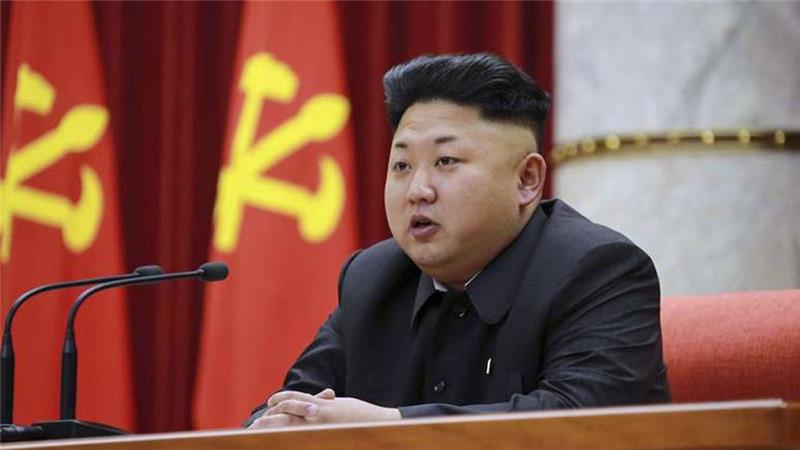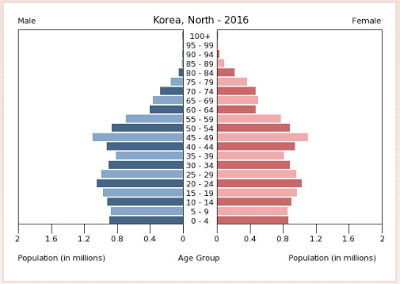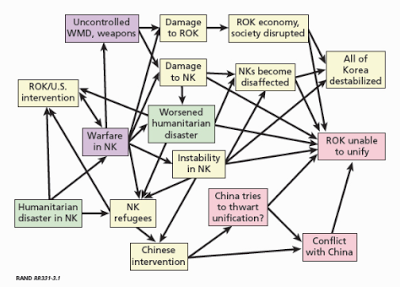
This article was last updated on April 16, 2022
Canada: ![]() Oye! Times readers Get FREE $30 to spend on Amazon, Walmart…
Oye! Times readers Get FREE $30 to spend on Amazon, Walmart…
USA: ![]() Oye! Times readers Get FREE $30 to spend on Amazon, Walmart…
Oye! Times readers Get FREE $30 to spend on Amazon, Walmart…
A recent research report by Bruce W. Bennett at the RAND Corporation looks at the possibility of a collapse of the North Korean government. With North Korea making the news cycle on a regular basis, thanks in large part to their ballistic missile program and the assassination of the current Supreme Leader’s half-brother, Kim Jong-nam, in Malaysia, the conclusions drawn in this research report are particularly pertinent, especially given these recent comments from U.S. Secretary of State, Rex Tillerson, when commenting on North Korea:
“Let me be very clear: the policy of strategic patience has ended. We are exploring a new range of security and diplomatic measures. All options are on the table.”
For the purposes of this posting, I would like to focus on the issues surrounding the potential negative consequences of a collapse of the Kim family dynasty on the North Korean people.
Let’s look at a bit of background information on North Korea to help set the tone for this posting. According to the CIA World Factbook, in 2016, North Korea had an estimated population of 25,115,311 with 20.97 precent of the population being 14 years old or younger and 44.22 percent of the population being between the ages of 25 and 54 years. Here is a population pyramid showing the age and gender breakdown:
Of the total, 60.9 percent live in urban areas with Pyongyang, the nation’s capital, being the largest city with a population of 2.863 million. Life expectancy at birth is 66.6 years for males and 74.5 years for females, putting the nation in 157th place out of 224 nations. By way of comparison, the life expectancy in South Korea is 79.3 years for males and 85.8 years for females. North Korea’s economy is quite small; its GDP in 2014 was $40 billion (115th place globally) and it had an estimated growth rate of 1.0 percent in 2014. Its per capita GDP is $1,800, putting it in 211th place out of 224 nations. By way of comparison, South Korea’s GDP is $1.929 trillion (14th place globally) and its per capita GDP is $37,900, putting it in 45th place. The nation has a labour force of 14 million with 37 percent being employed in the agricultural sector and 63 percent being employed in the nation’s industrial and services sector. The unemployment rate in 2013 was estimated at 25.6 percent.
Let’s take a closer look at the North Korean military. According to the latest version (2015) of the U.S. Department of State’s World MilitaryExpenditures and Arms Transfers, North Korea has 1.17 million active Armed Forces personal which makes up 4.8 percent of its population. The vast majority are in the nation’s land forces (934,000) follows by the Air Force/air defence sector (109,000) Military expenditures in 2014 consumed 24 percent of the nation’s GDP, up slightly from the 10 year average of 23.3 percent.
Now, let’s get to the subject matter of this posting. A collapse of the current North Korean regime could have consequences for nations that are economically tied to Northeast Asia, particularly if civil war should break out and the region is flooded with refugees, a situation that the global community has been experiencing as a result of the civil war in Syria. Let’s look at the impact of a collapse in the current North Korean regime:
1.) Central Government Functional Failure: If the North Korean central government fails, any services that it provides would also fail. There would likely be a degradation in local police and other security forces, leading to an increase in crime rates. The North Korean military would likely divide into factions lead by former military commanders who would be tasked with keeping the civilian population under control. These factions are likely to have high failure rates with weaker factions being subjected to purges, a factor that would lead to even greater levels of social instability. As has been the case throughout history, faction leaders may be brutal in eliminating disloyal individuals and are likely to crush any forms of dissent. Again, this scenario is playing out in the current Syrian civil war.
2.) Regional Conflict: Should the Kim regime foresee an apparent collapse, they may initiate a diversionary war by invading South Korea. Such a move would result in significant human and economic damage to both nations and could well lead to intervention by China, Russia and the United States. Should North Korean military forces be defeated (not a certainty given the possibility of assistance from the People’s Liberation Army), the United States may feel compelled to complete the surrender of the North Korean forces and the removal of the remnants of the Kim family dynasty. At the very least, U.S. forces may enter North Korea to deliver humanitarian assistance. The recent lessons taught by the conflict in Iraq show that this scenario is highly simplistic; internal conflict within North Korea is likely to continue even if their forces are pushed out of South Korea. With there being as many as 9 million potential North Korean combatants (including reservists), faction leaders that arise after the regional conflict could have plenty of “firepower”.
3.) Food Shortages and Related Health Consequences: As has become apparent, the North Korean regime already has significant difficulties feeding its population at the best of times. Any appearance of systemic instability would likely result in wealthier North Koreans hoarding food, further reducing the supply to those who are most vulnerable. As well, mounting food scarcity is likely have two negative impacts; first, in increasing attempts by factional forces to acquire food through the use of force and second, in skyrocketing food prices. Obviously, any scenario would be highly dependent on the crop yields experienced immediately before the regime collapse and the time of year in which the collapse occurred. A shortage of food is likely to lead to an increase in disease, particularly since North Korea already suffers from higher levels of scarlet fever, measles and typhoid. This will likely push the nation’s already low life expectancy to even lower levels.
4.) Human Rights Consequences: The collapse of the Kim family regime is likely to have a significant impact on human rights with an increase in revenge attacks against the nation’s security apparatus or that the security apparatus could act to kill its perceived enemies. According to the U.S. government’s Human Rights website, there are between 80,000 and 120,000 political prisoners and their family members held in six of the nation’s prison camps, some of which are as large as 25 miles by 31 miles in size. Guards in these camps are part of the Ministry of State Security and are often extremely brutal in their treatment of their charges. Some experts feel that it is quite likely that the North Korean regime could execute the tens of thousands of political prisoners in its “care” to avoid criminal prosecution if it appears that the regime is about to collapse.
5.) Internal Displacement and Refugees: In the mid-1990s, neighbouring China found itself battling a North Korean refugee crisis when the multi-year famine resulted in a flood of North Koreans crossing the border in a desperate search for food. In the case of North Korea, the north end of the peninsula is located between China and South Korea; this means that there could be a very large exodus of refugees into both nations. The barrier formed by the heavily mined demilitarized zone and the fact that about 80 percent of North Koreans live in the north of the nation around Pyongyang makes it more likely that the refugees will flee north into China, however, official South Korean projections suggest that up to 3 million North Koreans could flee to the south. That said, experts feel that it is most likely that would-be North Korean refugees will choose internal displacement since China has proven that is not terribly open to receiving North Koreans.
In closing, here is a graphic that shows the interrelationships between the potential consequences of a collapse of the Kim family dynasty:
In the long-run, it is quite likely that unification of the Korean Peninsula could make the combined North and South Koreas an economic powerhouse, however, as we have learned from experiences of the past, such unifications also have significant unintended consequences that cannot be foreseen. As well, the Korean War which took three years and the lives of 2.5 million people, including more than a million combat casualties, ended up being a less than satisfying 60 year stalemate.
Click HERE to read more.
Vote for Shikha Dhingra For Mrs South Asia Canada 2017 by liking her Facebook page.
You can publish this article on your website as long as you provide a link back to this page.




Be the first to comment